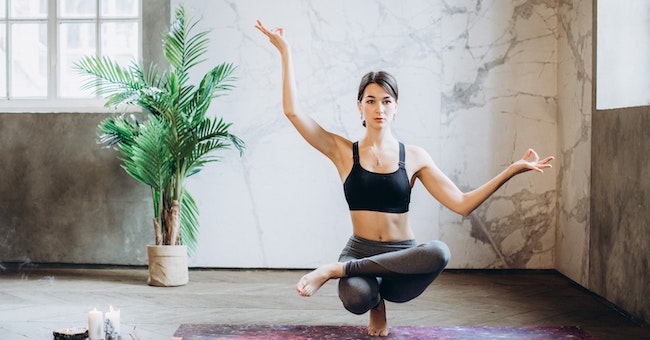Discovering the Essence of Ashtanga Yoga: A Journey to Physical and Spiritual Well-Being

Introduction
Ashtanga Yoga, also known as the "Eight-Limbed Yoga," is a profound and ancient system of yoga that embraces both physical and spiritual aspects of human existence. Rooted in the teachings of the Yoga Sutras of Patanjali, Ashtanga Yoga offers a holistic approach to attaining harmony and balance in life. This blog will take you on a journey to explore the essence of Ashtanga Yoga, its principles, benefits, and how it can transform your physical and spiritual well-being.
The Origins and Philosophy of Ashtanga Yoga
Ashtanga Yoga traces its origins back to the ancient text, the Yoga Sutras of Patanjali, which outlines the eight-fold path to spiritual enlightenment. These eight limbs, known as Yama (ethical disciplines), Niyama (observances), Asana (postures), Pranayama (breath control), Pratyahara (withdrawal of senses), Dharana (concentration), Dhyana (meditation), and Samadhi (ultimate state of oneness), serve as a comprehensive guide to leading a balanced and purposeful life.
Asana: The Foundation of Ashtanga Yoga
Asana, the third limb of Ashtanga Yoga, is the practice of physical postures. Ashtanga Yoga is often associated with a dynamic and rigorous sequence of postures that synchronizes breath with movement. The Primary Series, known as Yoga Chikitsa, is the foundation for the subsequent series, and it aims to purify and strengthen the body, promoting flexibility and balance.
Vinyasa: The Breath-Movement Link
Vinyasa, meaning "breath-synchronized movement," is a key component of Ashtanga Yoga. Each movement is linked to a specific breath, creating a seamless flow of energy throughout the practice. The synchronized breath not only enhances the physical aspects of the practice but also cultivates a deep sense of mindfulness and concentration.
Benefits of Ashtanga Yoga
Ashtanga Yoga, a dynamic and physically challenging practice, offers numerous benefits for the body, mind, and spirit. Here are some of the key benefits of practicing Ashtanga Yoga:
Physical Strength and Flexibility: Ashtanga Yoga involves a series of postures that work on building strength and flexibility in the entire body. The practice includes standing poses, forward bends, backbends, and inversions, which help tone and stretch the muscles, improving overall physical health.
Improved Cardiovascular Health: The dynamic nature of Ashtanga Yoga, combined with synchronized breathing, creates a cardiovascular workout, promoting a healthy heart and improved blood circulation.
Stress Reduction: Ashtanga Yoga incorporates breath control and meditation techniques that help reduce stress and anxiety, promoting a sense of calmness and mental clarity.
Increased Focus and Concentration: The structured sequences and flow of Ashtanga Yoga demand concentration and mindfulness, enhancing mental focus and attention.
Detoxification: The practice involves deep breathing and sweating, which aids in detoxifying the body by flushing out toxins and impurities.
Enhances Balance and Coordination: Ashtanga Yoga includes various balancing poses that improve stability and coordination, enhancing body awareness and proprioception.
Better Posture and Alignment: The emphasis on proper alignment in Ashtanga Yoga helps improve posture, reducing the risk of musculoskeletal issues.
Boosts Immunity: The practice stimulates the lymphatic system, which is essential for a robust immune system, thereby enhancing the body's ability to fight illnesses.
Mental Clarity and Emotional Balance: Ashtanga Yoga's meditative components promote mental clarity and emotional balance, helping practitioners manage stress and emotions more effectively.
Increased Self-Discipline: The traditional Ashtanga practice requires dedication and commitment to regular practice, instilling self-discipline and a sense of accomplishment.
Inner Awareness and Mindfulness: Ashtanga Yoga encourages self-reflection and inner awareness, fostering a deeper connection with oneself and others.
Spiritual Growth: For some practitioners, Ashtanga Yoga is a spiritual journey that goes beyond the physical practice, leading to a deeper understanding of oneself and the world.
Builds Endurance and Stamina: The repetitive nature of Ashtanga sequences builds endurance and stamina over time, improving overall physical fitness.
Better Breathing Techniques: The synchronization of breath and movement in Ashtanga Yoga enhances lung capacity and promotes efficient breathing techniques.
Increased Energy Levels: Regular Ashtanga practice can lead to improved energy levels, reducing fatigue and increasing vitality.
It is essential to practice Ashtanga Yoga under the guidance of a qualified instructor, especially for beginners, to ensure proper alignment and minimize the risk of injury. With consistent practice, Ashtanga Yoga can bring transformative benefits to one's overall well-being, promoting a balanced and harmonious lifestyle.
The Role of Bandhas and Drishti
Bandhas, or energetic locks, are vital components of Ashtanga Yoga that help to control the flow of energy within the body. When engaged, bandhas create stability and support in various postures. Drishti, or focused gaze, encourages concentration and aids in drawing the mind inward during the practice.
The Ashtanga Yoga Mysore Style
The Mysore style is a unique and traditional way of practicing Ashtanga Yoga. In this method, students practice the sequence at their own pace and receive individualized guidance and adjustments from the teacher. The Mysore style fosters a deep connection with the practice and allows students to progress gradually, honoring their unique abilities.
Overcoming Challenges in the Ashtanga Yoga Journey
Embarking on an Ashtanga Yoga journey can present both physical and mental challenges. The intensity of the practice, coupled with the self-discipline it demands, may be daunting at times. However, it is essential to approach these challenges with patience and self-compassion. Consistency, rather than perfection, is key to progress in Ashtanga Yoga.
The Spiritual Essence of Ashtanga Yoga
Beyond the physical postures lies the spiritual essence of Ashtanga Yoga. The integration of the eight limbs aims to transcend the ego, quiet the fluctuations of the mind, and experience oneness with the universe. Through meditation and self-reflection, practitioners can access deeper levels of consciousness and connect with their true selves.
Tips for Ashtanga Yoga
Ashtanga Yoga is a dynamic and transformative practice that requires dedication and discipline. Whether you are a beginner or an experienced practitioner, here are some essential tips to enhance your Ashtanga Yoga journey:
Start with the Basics: If you're new to Ashtanga Yoga, begin with the Primary Series (Yoga Chikitsa) and master the foundational postures before progressing to advanced sequences.
Practice Regularly: Consistency is key in Ashtanga Yoga. Try to establish a regular practice schedule, even if it's just a few minutes each day. Gradual progress will yield significant results over time.
Listen to Your Body: Respect your body's limitations and avoid pushing yourself too hard. Ashtanga Yoga is a challenging practice, but it's essential to practice mindfully and avoid overexertion to prevent injuries.
Focus on Breath: Pay close attention to your breath throughout the practice. The breath is the foundation of Ashtanga Yoga, and synchronized breathing enhances both the physical and meditative aspects of the practice.
Use Props: Don't hesitate to use props like blocks, straps, or bolsters to support your practice. Props can help improve alignment and assist you in achieving correct postures.
Incorporate Pranayama: Include pranayama (breath control) practices in your routine to enhance lung capacity and cultivate a calm and focused mind.
Find a Qualified Teacher: If possible, practice under the guidance of an experienced and certified Ashtanga Yoga teacher. They can offer personalized guidance, adjustments, and valuable insights.
Mysore Style Practice: Consider trying the Mysore style of practice, where you can practice at your own pace with individualized guidance from the teacher. It allows for a deeper connection with the practice and self-discovery.
Warm-Up Properly: Begin each practice with gentle warm-up exercises to prepare your body for the more challenging postures ahead.
Respect Rest Days: Ashtanga Yoga can be physically demanding. Honor rest days and allow your body to recover and rejuvenate.
Practice Mindfulness: Be fully present during your practice. Mindfulness helps deepen your connection with the practice and brings a sense of peace and inner awareness.
Embrace the Journey: Ashtanga Yoga is a journey of self-discovery and growth. Embrace each step, celebrate progress, and be patient with yourself. Avoid comparing your practice to others and focus on your personal growth.
Maintain a Balanced Lifestyle: Incorporate a balanced and healthy diet, adequate sleep, and self-care practices into your routine to support your Ashtanga Yoga journey.
Remember, Ashtanga Yoga is not about achieving perfection in postures but about the process of self-exploration and growth. Embrace the challenges and joys of the practice, and with dedication, you will experience the transformative power of Ashtanga Yoga in your life.
Recommended Online Resources for Ashtanga Yoga
30 Minute Yoga Ashtanga Express Class David and Jelena Yoga
Welcome to our channel featuring Ashtanga tutorials, from quick 5-10 minute lessons to longer 30+ minute led classes suitable for all experience levels. In this 30-minute express class, David will guide you through the standing sequence, backbends, and closing poses, while Jelena expertly demonstrates each posture.
Course highlights:
Quick 30-minute Ashtanga class with David and Jelena.
Covers standing sequence, backbends, and closing poses.
Suitable for all levels of experience.
Find more classes and pose tutorials on their channel.
Subscribe for free yoga and explore their online course library.
Ashtanga Yoga Beginners&s; Course
The "Ashtanga Yoga Beginners' Course" offers a structured and accessible pathway for individuals new to Ashtanga Yoga. Starting with the fundamental aspects and philosophy, learners will progress through foundational postures, standing sequences, forward bends, balance postures, and backbends. Emphasis is placed on proper alignment, breath coordination, and mindfulness, providing a solid foundation for a sustainable Ashtanga Yoga practice.
Course highlights:
Structured and accessible pathway for Ashtanga Yoga beginners.
Detailed introduction to philosophy, principles, and foundational postures.
Develop strength, flexibility, and body awareness with guided standing postures.
Explore balance postures and backbends for physical and mental resilience.
Emphasis on alignment, breath coordination, and mindfulness for sustainable practice.
60 Minute Led Ashtanga Half Primary Series David & Jelena Yoga
This class will guide you through half of the primary series up to Navasana, along with the full closing sequence. David provides expert guidance, while Jelena demonstrates each pose. Options and modifications are offered throughout the session, making it suitable for practitioners of all levels. Get ready to dive deeper into your Ashtanga practice and experience the benefits of this dynamic and traditional yoga style.
Course highlights:
60-minute led Ashtanga Half Primary Series with expert guidance.
David leads up to Navasana + full closing; Jelena demonstrates each pose.
Options and modifications offered for all levels of experience.
Explore more classes and request pose tutorials in the comments.
Conclusion
Ashtanga Yoga is a profound and transformative practice that extends far beyond the realm of physical exercise. Its holistic approach offers practitioners an opportunity to embark on a journey of self-discovery, cultivating physical strength, mental clarity, and spiritual growth. Whether you are new to yoga or an experienced practitioner, Ashtanga Yoga provides a pathway to inner peace and a profound connection with the essence of life itself. As you embark on this beautiful journey, remember that every step counts, and the true essence of Ashtanga Yoga lies in embracing the process and being present in each breath, on and off the mat. Namaste.





